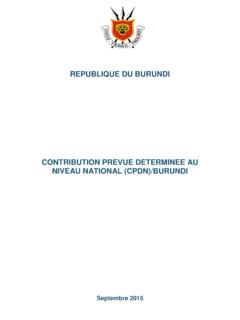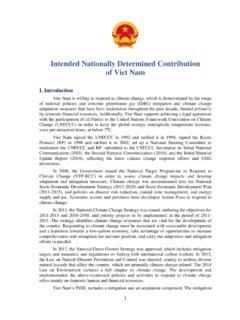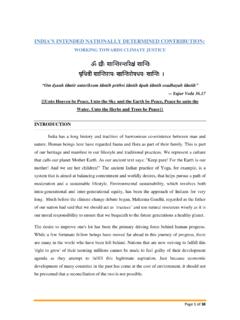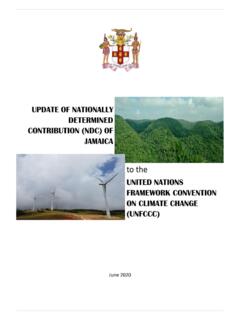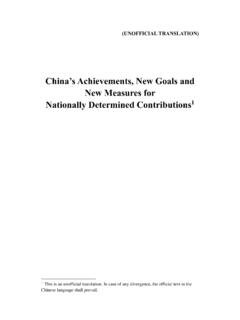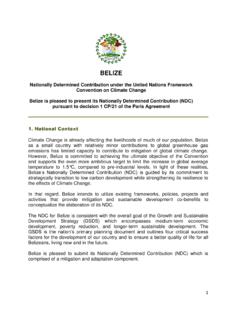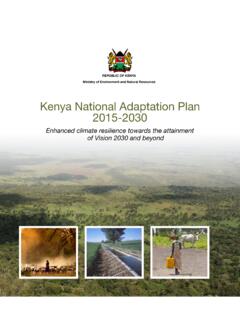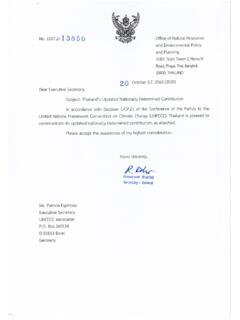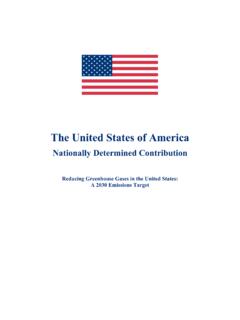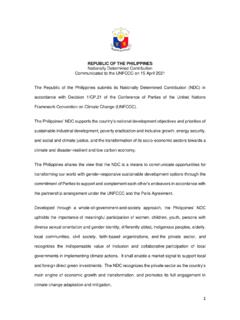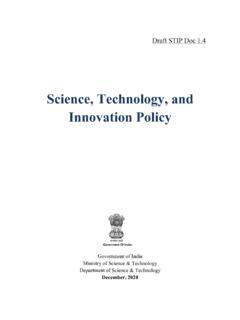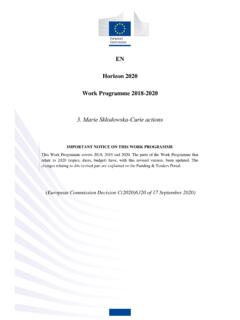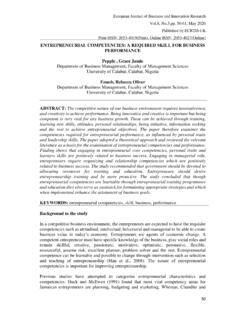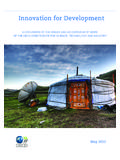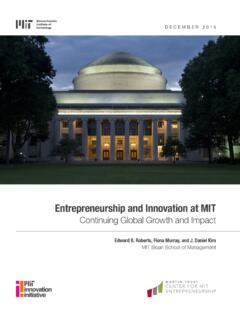Transcription of FIRST NATIONALLY DETERMINED CONTRIBUTION REPUBLIC …
1 FIRST NATIONALLY DETERMINED CONTRIBUTION REPUBLIC OF INDONESIA November 2016 FIRST NATIONALLY DETERMINED CONTRIBUTION REPUBLIC OF INDONESIA 1. NATIONAL CONTEXT Indonesia is a nascent yet stable democracy and the fourth most populous country in the world. Despite continuous, multi-decade economic growth, approximately 11% of Indonesia s population is living below the poverty line. To lift people out of poverty, the Government of Indonesia (GOI) is promoting economic development projected to average at least 5% per year in order to reduce the poverty rate to below 4% by 2025, as mandated by the Indonesian Constitution, inter alia, that every person shall have the right to enjoy a good and healthy environment. As climate change becomes a reality, Indonesia continues to seek a balance between its current and future development and poverty reduction priorities.
2 In 2010 the Government of Indonesia pledged to reduce emissions by 26% (41% with international support) against the business as usual scenario by 2020. The current administration, under President Joko Widodo, has DETERMINED priority actions within the national Nawa Cita (Nine Priority Agendas) framework, which includes protecting Indonesia s citizens, encouraging rural and regional development, improving the quality of life, and improving productivity and global competitiveness. These core missions are consistent with the national commitment towards a low carbon and climate change-resilient development path, in which climate change adaptation and mitigation constitute an integrated and cross-cutting priority of the National Medium-Term Development Plan. The following priorities for enhanced actions in 2015-2019 will be fully integrated into Indonesia s National Medium-Term Development Plan in 2020.
3 Given its pivotal geographic position in the global ocean conveyor belt (thermohaline circulation), the largest archipelagic country and its extensive tropical rainforests with high biodiversity, high carbon stock values and energy and mineral resources, Indonesia is recognized its role to play in combatting global climate change. Nevertheless, Indonesia is vulnerable to natural disaster that will likely be exacerbated by climate change, especially in low-lying areas throughout the archipelago. Therefore Indonesia views comprehensive land and ocean-based climate change adaptation and mitigation efforts as a critical strategic consideration in achieving climate resilience in food, water and energy. Indonesia s NATIONALLY DETERMINED CONTRIBUTION (NDC) outlines the country s transition to a low carbon and climate resilience future. The NDC describes the enhanced actions and the 2 necessary enabling environment during the 2015-2019 period that will lay the foundation for more ambitious goals beyond 2020, contributing to the concerted effort to prevent 20C increase in global average temperature and to pursue efforts to limit the temperature increase to above pre-industrial levels.
4 For 2020 and beyond, Indonesia envisions achieving archipelagic climate resilience as a result of comprehensive adaptation and mitigation programmes and disaster risk reduction strategies. Indonesia has set ambitious goals for sustainability related to production and consumption of food, water, and energy. These goals will be achieved by supporting empowerment and capacity building, improved provision of basic services in health and education, technological innovation , and sustainable natural resource management, in compliance with principles of good governance. 2. MITIGATION According to Indonesia s Second National Communication of 2010, national greenhouse gas (GHG) emissions were estimated to be GtCO2e in 2005. This represents an increase of GtCO2e compared to 2000. Most emissions (63%) are the result of land use change and peat and forest fires, with combustion of fossil fuels contributing approximately 19% of total emissions.
5 Based on Indonesia s FIRST Biennial Update Report (BUR) submitted to UNFCCC in January 2016, national greenhouse gas (GHG) emissions was GtCO2e in 2012 which represent an increase of 0,452 GtCO2e from year 2000. The main contributing sectors were LUCF including peat fires ( ) and energy (34,9%). Since Indonesia voluntarily pledged to reduce emissions by 26% on its own efforts, and up to 41% with international support, against the business as usual scenario by 2020, Indonesia has promulgated relevant legal and policy instruments, including the national action plan on GHG emissions reduction as stipulated in Presidential Regulation (PERPRES) No. 61/2011 and GHG inventory through Presidential Regulation (PERPRES) No. 71/2011. Post 2020, Indonesia envisions a progression beyond its existing commitment to emission reductions. Based on the country s most recent emissions level assessment, Indonesia has set unconditional reduction target of 29% and conditional reduction target up to 41 % of the business as usual scenario by 2030.
6 Indonesia has taken significant steps to reduce emissions in land use sector by instituting a moratorium on the clearing of primary forests and by prohibiting conversion of its remaining forests by reducing deforestation and forest degradation, restoring ecosystem functions, as well as sustainable forest management which include social forestry through active participation of the private sector, small and medium enterprises, civil society organizations, local communities and the most vulnerable groups, especially adat communities (Indonesia: Masyarakat Hukum Adat, internationally known as Indigenous People), and women in both 3 the planning and implementation stages. A landscape-scale and ecosystem management approach, emphasizing the role of sub-national jurisdictions, is seen as critical to ensure greater and more enduring benefits from these initiatives. REDD+ will be an important component of the NDC target from land use sector.
7 Forest Reference Emission Level (FREL) for REDD+ was submitted to the UNFCCC Secretariat in December 2015, covering deforestation and forest degradation and peat decomposition. The FREL was set at GtCO2e yr-1 (AGB), using reference period of 1990 2012 and will be used as the benchmark against actual emission starting from 2013 to 2020. These figures should be used as benchmark for evaluating REDD+ performance during the implementation period (up to 2020). Indonesia will adjust the FREL for post-2020 or earlier when necessary. In energy sector, Indonesia has embarked on a mixed energy use policy. Indonesia has also established the development of clean energy sources as a national policy directive. Collectively, these policies will eventually put Indonesia on the path to de-carbonization. Government Regulation No. 79/2014 on National Energy Policy, set out the ambition to transform, by 2025 and 2050, the primary energy supply mix with shares as follows: a) new and renewable energy at least 23% in 2025 and at least 31% in 2050; b) oil should be less than 25% in 2025 and less than 20% in 2050; c) coal should be minimum 30% in 2025 and minimum 25% in 2050; and d) gas should be minimum 22% in 2025 and minimum 24% in 2050.
8 For the waste management sector, the GOI is committed to develop a comprehensive strategy to improve policy and institutional capacity at the local level, enhance management capacity of urban waste water, reduce landfill waste by promoting the Reduce, Reuse, Recycle approach, and the utilization of waste and garbage into energy production. The GOI is committed to further reduce emissions from the waste management sector by 2020 and beyond, through comprehensive and coherent policy development, institutional strengthening, improved financial and funding mechanisms, technology innovation , and social-cultural approaches. 3. ADAPTATION Climate change presents significant risks for Indonesia s natural resources that will, in turn, impact the production and distribution of food, water, and energy. Therefore, the GOI considers climate mitigation and adaptation efforts as an integrated concept that is essential for building resilience in safeguarding food, water and energy resources.
9 The GOI has made significant efforts towards developing and implementing a National Action Plan on Climate 4 Change Adaptation (RAN-API) which provides a framework for adaptation initiatives that has been mainstreamed into the National Development Plan. The GOI will implement enhanced actions to study and map regional vulnerabilities as the basis of adaptation information system, and to strengthen institutional capacity and promulgation of climate change sensitive policies and regulations by 2020. The medium-term goal of Indonesia s climate change adaptation strategy is to reduce risks on all development sectors (agriculture, water, energy security, forestry, maritime and fisheries, health, public service, infrastructure, and urban system) by 2030 through local capacity strengthening, improved knowledge management, convergent policy on climate change adaptation and disaster risks reduction, and application of adaptive technology.
10 Pre 2020 policies and actions will facilitate smooth transition towards implementation of NATIONALLY DETERMINED CONTRIBUTION under the Paris Agreement post 2020. The following pre 2020 policies and actions will lay a strong foundation for adaptation actions from 2020 onwards : 1) Pre-condition: Development of nation wide climate vulnerability index data Information System, built on the existing system known as SIDIK (Vulnerability Index Data Information System) which allows public access to the information in the system website ( ) Ministerial Regulation No. on Guideline for development of National Adaptation Plan (NAP). The regulation allows sub national government to formulate their own Sub National Adaptation Plan (Sub NAP) Enhance existing National Action Plan on Climate Change Adaptation that has been formulated in 2014.
